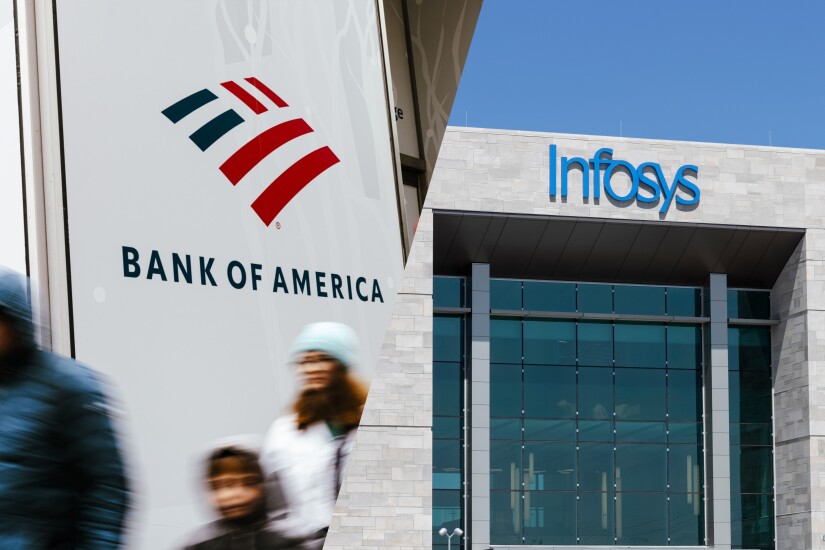In this month's roundup of top tech news:

Data breach affects 57,000 Bank of America accounts
An unauthorized party — apparently a ransomware group known as
The breach occurred Nov. 3, according to the letter, and Infosys McCamish notified Bank of America about the breach on Nov. 24.

Banking-as-a-service banks: 'There is a reckoning'
"The number one takeaway for banks has to be that banking as a service is not the silver bullet many of them thought it would be for deposit gathering," said Jason Henrichs, founder and CEO of community bank consortium
Banks are

How BMO merged its technology with Bank of the West's
"For 13 months prior to regulatory approval, BMO was doing a ton of work with strategy sessions, but we were still competitors with Bank of the West, so we were not allowed to have any discussion about data," said Angela Sim, the chief technology resiliency, experience and operations officer at BMO. "The moment the regulators gave us the go was prime time for us to move very quickly."
When one bank acquires another, efforts to integrate technology must be put on hold until regulators have given the green light. Once that happens,

Pig butchering: The scam that hastened a bank's failure
American Banker reported previously that the bank's failure had been
"Heartland Tri-State Bank failed because of alleged fraudulent activity conducted by the bank's chief executive officer (CEO), who initiated a series of wire transfers totaling about $47.1 million of Heartland's funds, among other suspicious activities, as part of an apparent cryptocurrency scheme referred to as 'pig butchering,'" the report said.

This Virginia bank wants to rewrite the rules for banking as a service
The $2 billion-asset MainStreet has trumpeted Avenu, its banking-as-a-service subsidiary, as a potential game changer since introducing it more than two years ago. At year-end 2023, MainStreet reported $35.3 million of Avenu deposits, $33.5 million of which were non-interest-bearing. MainStreet is forecasting Avenu will reach its projected breakeven point, $225 million of total deposits, this year.
As predictions go, that's bold. If Avenu hits the target, it will have grown deposits more than 530%. The lion's share of those deposits, moreover, would be non-interest-bearing, helping set MainStreet apart from an industry grappling with increased funding costs. It could also establish the 2-year-old subsidiary as an alternative to the way many banks have pursued embedded banking, through so-called middleware.

Green Dot sets aside $20 million after draft AML order from Fed
Green Dot has set aside $20 million related to the proposed order, Chief Financial Officer Jess Unruh said on its quarterly earnings call on Feb. 27. The enforcement action, which includes civil money penalties, could end up costing as much as $50 million, according to an 8-K report the company filed the same day.
The company continues to invest in its anti-money-laundering program "to remediate the matters addressed in the proposed consent order, ensure we have market-leading compliance programs and to mitigate and reduce our fraud losses over the long term," Unruh said. "Over time, we believe that this will be a competitive advantage."

The budding promise of tokenization in banking
JPMorgan Chase and Citigroup are two institutions that have put concrete use cases into action. Some experts think of these efforts as where cloud computing stood in financial services a couple of decades ago.
"You don't necessarily need the cloud to run workflows and process data, but it can make them more efficient and you can scale capacity," said Thomas Olsen, who leads the financial market infrastructure practice at consulting firm Bain. "It's still a slow and painful migration."

Why Citi is rolling out generative AI to all its developers
For instance, the bank will have a road map for rolling out GitHub Copilot to all developers – about 40,000 employees – by mid-April, according to Shadman Zafar, CIO of personal banking and wealth management at Citi and lead for its generative AI work. This should save a lot of time, especially where reusable code can be found within the bank's own repository. Citi is also using generative AI to modernize legacy systems and do first drafts of compliance assessments, among other things.
"I do believe it's a technology that will, in a sustainable way, have a long-term impact on how we do work for a couple of decades to come," Zafar said in an interview.

JPMorgan Chase, TD draw AI talent through research labs
"Jamie Dimon went out and said, we're going to be an AI-first bank and we're going to actually be a tech company," said Alexandra Mousavizadeh, founder and CEO of Evident, in an interview. Recognizing that one of the things tech companies have is AI research labs, he hired Manuela Veloso, who had been a Carnegie Mellon University professor since 1992 and who is a "leading brain on AI," to run it.
There are two reasons why AI research labs are important, and why the number of banks doing AI research has jumped from 10 to 40 of the top 50 last year, according to Mousavizadeh.

The rise of the bank chief AI officer
This isn't always the exact job title, but at the majority of large banks, someone at the top of the organization is being given responsibility for AI projects. According to the Institute of International Finance, 66% of banks worldwide have a C-suite manager overseeing AI or machine learning. In the U.S., 75% of institutions have already appointed a C-suite manager responsible for AI/machine learning ethics and governance.
Examples of top AI executives include Teresa Heitsenrether, chief data and analytics officer of JPMorgan Chase; Chintan Mehta, CIO for digital, innovation and strategy at Wells Fargo; and Dominic Venturo, chief digital officer at U.S. Bank.





